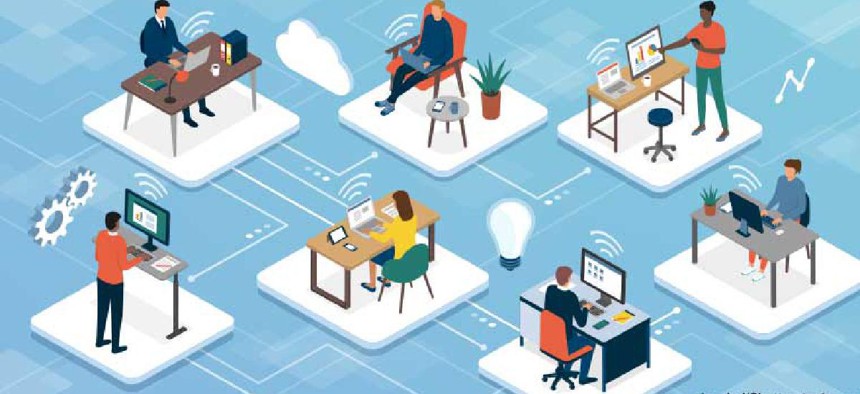Post-pandemic IT leadership

The rush to maximum telework did more than showcase the importance of IT -- it also forced them to rethink their own operations.

Since at least the days of Clinger-Cohen, there have been efforts to secure IT leaders "a seat at the table" — to be full partners in the business and strategy of an agency, rather than serving as tech support after the decisions are made. And nearly 18 months of COVID-upended operations showed just how important that seat at the (now-virtual) table can be. IT modernization and tech-driven innovation were the cornerstone of effective government operations though the pandemic.
FCW recently gathered a group of IT leaders from both the federal and local levels to explore how they are adapting to the "new normal" as emergency pandemic measures give way to permanently changed citizen and employee expectations. The goal was to see how CIOs, CTOs and other key leaders have seen their fundamental roles and priorities evolve, and where they expect to focus their energies in the months to come.
The discussion was on the record but not for individual attribution (see sidebar for full list of participants), and the quotes have been edited for length and clarity. Here's what the group had to say.
IT in the spotlight
For most of the participants, the pandemic was a very public demonstration of the value that their teams deliver. "I think people have a deeper and a more relevant appreciation for the power of technology and enablement from a leadership perspective," one CIO said. That was true to some degree pre-COVID, but "now it's definitely a peer-to-peer understanding that the mission, the operations aren't possible without the undercurrent of the technology."

Participants
Shane Barney
Chief Information Security Officer, Department of Homeland Security
Winston Beauchamp
Deputy CIO, Department of the Air Force
Guy Cavallo
Deputy CIO, Office of Personnel Management
Lou Charlier
Deputy CIO, Department of Labor
La'Naia Jones
Deputy CIO, National Security Agency
Heather Kowalski
CIO, INTERPOL-USNCB, Department of Justice
Kimberly LaGrue
CIO, City of New Orleans
Jonathan Nguyen-Duy
Vice President and Field Chief Information Security Officer, Fortinet
Eric Quinn
Director, Global IT Modernization, Department of State
Jim Richberg
Field Chief Information Security Officer, Fortinet
Christophe St. Luce
CIO, City of Venice (Fla.)
Note: FCW Editor-in-Chief Troy K. Schneider led the roundtable discussion. The June, 2021, gathering was underwritten by Fortinet, but both the substance of the discussion and the recap on these pages are strictly editorial products. Neither Fortinet nor any of the roundtable participants had input beyond their June 17 comments.
Whereas top agency executives might have previously viewed VPNs and bandwidth management as operational minutiae, the "started to really see the pipes because they were living through them," the official said. "And so people were seeing real time that, 'Hey, I think we need to make sure we have the tech folks involved in this because that could be the linchpin.' And so I'm hoping that that stays the same. I think that we all have short memories."
The speed at which many agencies pivoted to telework and remote collaboration also earned new credibility for the IT leaders who made it possible. "If nothing else, what that showed is we can move fast when the stops are out," one official said. "When we set the bureaucracy aside, it is absolutely possible."
"In no period of time that I can remember have we spent more of our corporate time talking about issues of IT," another participant said. "Both in terms of, 'help me get my VPN working for telework,' and also the imperative to change the way we do our mission."
Several participants also reported being sought out by business owners within their organization — not just for the IT to support remote work and digital transformation, but also for strategic advice.
A local-government official recounted that major departments used to operating on the ground in the community had never really thought about what it would take to transition to virtual citizen services. "Not having people in the office meant that you had to really think and address how you were going to provide your service to citizens remotely. So IT became the go-to and the authority on how to apply a digital, equitable lens to customer service in a society like ours."
"We had to serve up information about how customers could be serviced to those departments, and then help them come up with solutions on how they would continue customer service.
Not every organization embraced that perspective. "My biggest challenge over the last year is getting my superiors to have a realistic expectation of what a small IT team can do," said one official who said they were rarely if ever included in strategic discussions. "There's a lot that we have been able to do, and I salute my team on a regular basis for making it happen. But getting the bosses to understand that you came from an organization that has an IT team bigger than our entire organization. We simply cannot replicate what that other group does. We don't have the budget. We don't have the time."
And even where CIOs are now seen as a valued voice, the help-desk image persists. "We are a policy and strategy and enterprise architecture shop," one participant said, "but I still get calls from our front office saying, 'Hey, can we get some tablets? So we can look at PowerPoint slides in real time?' They can hold those two things in their heads somehow at the same time. Yes, we need to talk more about IT, but also just fix my tablet."
"We're strategists," another participant said. "We save the day, but then when the little glitch happens we're the dogs for the next two days. It's something I don't think we're ever going to get away from, but I do think that executive management and the administration is now seeing the value in IT, especially when we were able to react so well across the federal workspace to the pandemic."
Telework and the IT team
The rush to maximum telework did more than showcase the importance of IT, the group agreed. It also forced them to rethink their own operations.
"I think my biggest challenge with trying to figure out how we did telework and then how we transitioned to a hybrid model is really how I approach personnel management," one CIO said. "I've got 120 people on my team, and that they range from people who are about to retire, people who have never been married, people who have small children and are single parents. And I'm trying to maintain an awareness of how that person is going to be able to work. And if I make a snap judgment that, 'okay, we're all moving back to the office,' how is that going to impact people?"
Multiple participants said they were still wrestling the issues surrounding employees who want to move out of the area and transition to remote-worker status — practical questions about particular job functions, HR-related matters like locality pay and basic concerns about fairness and equity across their teams.
"We're really looking at OPM and others to standardize," one said, "because if each federal agency does it different, that's going to change the rules for everybody. And then you're going to lose staff to places where it's more telework friendly. Same with the staff that you're trying to attract or the contractors you're trying to hire."
At least two participants said they'd begun hiring contractors without regard to location, after long requiring those individuals to be locally based. And one noted that hiring government employees nationwide for remote work not only tapped new talent pools, but also made it easier to find qualified veterans hire — something federal agencies are expected to do.
In many organizations, however, the support for a permanently flexible work environment appears shaky at best.
"We closed our doors for three months last year, and then did a partial opening and had staff working remotely," one participant said. "We did a full return to work in late April of this year. So it'll be interesting to see if these telework policies are rewritten so that people can work remotely. It may not really happen until there's new leadership."
"Our senior leadership is still not used to people working from home," another official agreed. "They're kind of, 'You're working if your feet are under your desk.' That's how they think of things. Even though people have proven that we can do things remotely."
Some of the participants were more optimistic. "We're seeing a blend of how can we mesh the two worlds," one said. "We do have some folks that are looking to go back and do the stand-ups, the early-morning rigor. But at the same time, during the pandemic you've seen the balance of family life, personal time, taking time for yourself. And so I think that it's going to have to be a blend — and as with anything, we'll merge the worlds together and come out with the best."
New normal, new security concerns
After years of battling shadow IT in the office, the group agreed, a year-plus of telework has opened up new fronts in that struggle.
"How many of you have had a call to your help desk," one participant asked the group, "from someone who says, 'I just went to Costco and bought a printer now that I'm not coming to the office. And I need the IT office to hook it up.'" Virtually every head nodded yes.
"And then if your team is sharp, you start getting into a discussion about supply chain management and where that printer came from and its capabilities," the speaker continued. "We are going to come up with a list of probably five printers that we will support offices buying for home users, that we will provide the drivers for those. We will make sure that the supply chain for them is proper. We might even designate that they only can buy them through NASA SEWP or something like that, so that we can control the supply chain."
All the working from home has set new expectations, another official agreed. "Because we've been doing so much outside of work with tele-health and other things, people just have this false set of expectations for their everyday work life. And it's much more complicated, especially in the government, as it's not as easy and agile to be able to implement those types of solutions."
But there may be risk management upsides as well, another official noted. "You've seen in disaster movies the concentrated operations, right? Where we pick up the leadership of the Pentagon in the event of a nuclear strike and put them in the middle of a mountain somewhere to operate? I believe we have way more resilience by putting people at home because we distribute the leadership instead of concentrating them in one place."
"We have more resiliency to a natural disaster, more resiliency to a delivered attack, more resiliency to a cyber event than we would if we were putting them on a single string of servers on a single location. And so we've just got to fundamentally rethink all of that."
NEXT STORY: Hurricane Ida knocked out key NARA system


